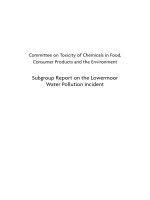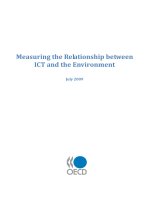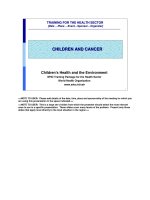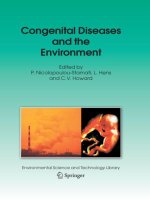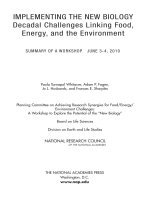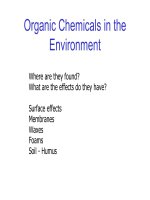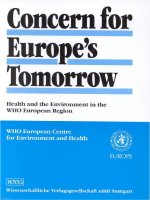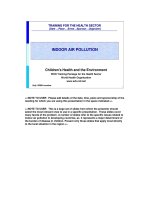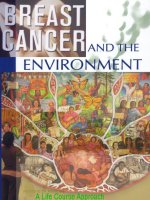Congenital Diseases and the Environment pdf
Bạn đang xem bản rút gọn của tài liệu. Xem và tải ngay bản đầy đủ của tài liệu tại đây (4.16 MB, 490 trang )
Congenital Diseases and the Environment
Environmental Science and Technology Library
VOLUME 23
Edited by
P. Nicolopoulou-Stamati
National and Kapodistrian University of Athens,
Medical School, Department of Pathology,
Athens, Greece
L. Hens
Vrije Universiteit Brussel,
Human Ecology Department,
Brussels, Belgium
and
C.V. Howard
Congenital Diseases
and the Environment
Bioimaging Research Group,
Centre for Molecular Biosciences, University of Ulster,
Coleraine, United Kingdom
A C.I.P. Catalogue record for this book is available from the Library of Congress.
ISBN-10 1-4020-4830-0 (HB)
ISBN-13 978-1-4020-4830-2 (HB)
ISBN-10 1-4020-4831-9 (e-book)
ISBN-13 978-1-4020-4831-9 (e-book)
Published by Springer,
P.O. Box 17, 3300 AA Dordrecht, The Netherlands.
www.springer.com
Printed on acid-free paper
Cover Images © 2006 JupiterImages Corporation.
All Rights Reserved
No part of this work may be reproduced, stored in a retrieval system, or transmitted
in any form or by any means, electronic, mechanical, photocopying, microfilming, recording
or otherwise, without written permission from the Publisher, with the exception
of any material supplied specifically for the purpose of being entered
and executed on a computer system, for exclusive use by the purchaser of the work.
© 200 Springer
7
Editorial Statement
It is the policy of AREHNA, EU–SANCO project, to encourage the full spectrum of opinions to be
represented at its meetings. Therefore it should not be assumed that the publication of a paper in
this volume implies that the Editorial Board is fully in agreement with the contents, though we
ensure that contributions are factually correct. Where, in our opinion, there is scope for ambiguity
we have added notes to the text, where appropriate.
Desktop publishing by Dao Kim Nguyen Thuy Binh and Vu Van Hieu.
v
TABLE OF CONTENTS
PREFACE xvii
ACKNOWLEDGEMENTS xxi
LIST OF CONTRIBUTORS xxv
LIST OF FIGURES xxxi
LIST OF TABLES xxxiii
LIST OF BOXES xxxvii
INTRODUCTION: CONCEPTS IN THE RELATIONSHIP
OF CONGENITAL DISEASES WITH THE ENVIRONMENT
P. NICOLOPOULOU-STAMATI
Summary 1
1. Introduction 2
2. The changing concepts of environmental influences in the causation
of congenital anomalies 3
3. Methods to study congenital anomalies and their links to the environment 4
3.1. EUROCAT: Surveillance of environmental impact 4
3.2. Endpoints for prenatal exposures in toxicological studies 4
3.3. Evidence from wildlife 5
3.4. Epidemiology 6
3.5. Clinical teratology 6
4. Chemicals and exposure conditions associated with congenital anomalies 7
4.1. Congenital diseases related to environmental exposure to dioxins 7
4.2. Association of intra-uterine exposure with drugs: the thalidomide
effect 7
4.3. Endocrine disrupter exposure and male congenital malformations 8
4.4. Links between in utero exposure to pesticides and their effects
4.5. Phthalates 9
5. Environmental congenital anomalies 10
5.1. Testicular dysgenesis syndrome 10
5.2. Endocrine disrupters, inflammation and steroidogenesis 10
on human progeny. Does European pesticide policy protect health? 9
TABLE OF CONTENTS
vi
5.3.
Environmental impact on congenital diseases:
the case of cryptorchidism 11
6. Policy aspects 12
6.1. Raising awareness of information society on impact of EU policies
and deployment aspects 12
6.2. The concerns of NGO’s related to congenital diseases 12
6.3. Environmental impacts on congenital anomalies – information
ofessional 13
7. Conclusions 13
References 14
SECTION 1:
METHODS
ENDPOINTS FOR PRENATAL EXPOSURES IN TOXICOLOGICAL
STUDIES
A. MANTOVANI AND F. MARANGHI
Summary 21
1. Introduction 22
2. An overview of regulatory tests in developmental toxicology 24
2.1. Prenatal development toxicity study (OECD guideline 414) 24
2.2. Two-generation reproduction toxicity study (OECD 416) 26
2.3. In vitro alternative tests for developmental toxicity 28
2.4. Developmental toxicity testing of environmental contaminants.
The example of endocrine disrupters. 30
3. Recommendations for further research in developmental toxicology 31
Acknowledgements 32
References 32
CONGENITAL DEFECTS OR ADVERSE DEVELOPMENTAL
EFFECTS IN VERTEBRATE WILDLIFE: THE WILDLIFE-HUMAN
CONNECTION
G. LYONS
Summary 37
1. Introduction: The animal – human connection and epigenetic
reprogramming 38
2. Summary of pollutant-related defects reported in wildlife 41
2.1. Fish 43
2.1.1. Deformities of sex-linked structures in fish 46
2.1.2. Poor reproductive success / reduced hatching in fish 47
2.1.3. Thyroid disruption in fish 47
for the non-expert pr
TABLE OF CONTENTS
vii
2.1.4.
Immunosuppression in fish 48
2.1.5. Altered osmoregulation in migrating fish 48
2.2. Birds 48
2.2.1.
Abnormal VTG production in male birds 49
2.2.2. Deformities of the reproductive tract, and ovo-testes in birds 49
2.2.3. Embryonic mortality and reduced reproductive success
in birds 49
2.2.4. Altered thyroid function in birds. 50
2.2.5. Immunosuppression in birds 50
2.2.6. Eggshell thinning in birds 51
2.2.7. Deformities of the bill and bone in birds 51
2.3. Reptiles 52
2.3.1. Effects in alligators 52
2.3.2. Effects on turtles 53
2.4. Amphibians 54
2.5. Mammals 56
2.5.1. Feral rodents 56
2.5.2. Otters 56
2.5.3. Mink 58
2.5.4. Seals and sea lions: Reproductive problems,
immunosuppression, adrenal and other effects in seals 59
2.5.5. Whales and other cetaceans 60
2.5.6. Polar bears 62
2.5.7. Black and brown bears 64
2.5.8. Florida panther 65
2.5.9. Sitka black tail deer 65
2.5.10.White tailed deer 66
2.5.11.Mule deer 66
2.5.12.Eland 66
3. Summary of some effects found in both humans and wildlife 67
3.1. Testicular dysgenesis syndrome / Intersex 67
3.2. Thyroid disruption 68
3.3. Immunotoxicity 69
3.4. Congenital defects of jaw, beak, claw, nails or teeth 71
4. Conclusions 71
References 72
EPIDEMIOLOGICAL METHODS
A. ROSANO AND E. ROBERT-GNANSIA
Summary 89
1. Introduction 89
2. Sources of data, coding and classification 92
TABLE OF CONTENTS
viii
2.1.
Source of data for congenital anomalies 92
2.2. Coding and classification of congenital anomalies 93
2.3. Accuracy of diagnosis and ascertainment of congenital anomalies 94
2.4. Source of data, coding and assessment of environmental exposures 95
3. Study designs 97
3.1. Cohort or follow-up study 99
3.2. Case-control studies 101
3.3. Ecological designs 103
3.3.1. Exploratory studies 105
3.3.2. Multiple-group comparison study 107
3.3.3. Space-time cluster study 107
3.4.
Case reports 109
4. Genetic epidemiology 109
4.1. Study designs in genetic epidemiology 110
5. Problems in environmental epidemiology when studying its effects
on reproduction 113
5.1. Living status of cases 113
5.2. Genetic susceptibility 115
5.3. Rare diseases, low-level exposures, and small effects 115
5.4. Identifying, quantifying, and timing exposures 116
5.5. Sources of errors 117
6. Conclusions 121
References 123
EUROCAT: SURVEILLANCE OF ENVIRONMENTAL IMPACT
H. DOLK
Summary 131
1. EUROCAT: What and why? 132
2. The prevalence of congenital anomalies 134
3. Environmental causes of congenital anomalies 135
4. EUROCAT surveillance of environmental impact 137
4.1. Approaches to surveillance 137
4.1.1. Assessment of trends in congenital anomaly prevalence 138
4.1.2. Routine detection of and response to clusters without a well
defined a priori exposure hypothesis 138
4.1.3. Systematic evaluation of environmental exposures 139
4.2. Envirovigilance 141
References 142
TABLE OF CONTENTS
ix
CLINICAL TERATOLOGY
M. CLEMENTI AND E. DI GIANANTONIO
Summary 147
1. Introduction 148
2. Teratogens 149
2.1. Basic principles of clinical teratology 150
2.2. Animal studies 151
2.3. Pharmacokinetics in pregnancy 152
2.4. Methods to identify human teratogens 153
2.5. Classification of drugs used in pregnancy 154
2.6. Criteria for proof of human teratogenicity 155
2.7. Teratogen Information Services (TIS) in Europe 155
3. Conclusions 157
References 15
SECTION 2
: TERATOGENS
DIOXINS AND CONGENITAL MALFORMATIONS
J.G. KOPPE, M. LEIJS, G. TEN TUSSCHER AND P.D. BOER
Summary 163
1. Introduction 164
2. Acute dioxin poisoning 166
2.1. Animal studies 166
2.2. Acute dioxin toxicity in man 166
2.2.1. Yushchenko 166
2.2.2. Two secretaries 167
2.3. Hormones 167
2.4. Thrombocytopenia 168
3. Hotspots of dioxin pollution 169
3.1. Amsterdam Diemerzeedijk 1961-1973 169
3.2. Yusho-disaster 1968 170
3.3. Yucheng-disaster 1978 170
3.4. Seveso-disaster 1976 171
3.5. Vietnam: Agent Orange spraying 1962-1971 172
3.6. Bashkortostan: 1965-1985 173
3.7. Chapaevsk 1967-1987 174
3.7.1. Prematurity 174
3.7.2. Intra-uterine growth retardation 174
3.7.3. Congenital morphogenetic conditions 174
3.7.4. Congenital malformations 175
3.7.5. Congenital hydrocephaly without spina bifida 175
9
TABLE OF CONTENTS
x
3.7.6.
Increasing type 1 diabetes 177
4. The role of vitamin A 177
5. Conclusion 178
References 178
LINKS BETWEEN IN UTERO EXPOSURE TO PESTICIDES
AND EFFECTS ON THE HUMAN PROGENY. DOES EUROPEAN
PESTICIDE POLICY PROTECT HEALTH?
C. WATTIEZ
Summary 183
1. Introduction 184
2. Congenital disorders 185
2.1. Congenital malformations 186
2.1.1. Several birth defects 186
2.1.2. Central nervous system defects 187
2.1.3. Cardiovascular defects 187
2.1.4. Orofacial clefts 188
2.1.5. Urogenital defects 188
2.1.6. Limb defects 188
2.2. Other congenital disorders 192
2.2.1. Intrauterine growth retardation 193
2.2.2. Neurodevelopmental impairments 193
3. Does European pesticide policy protect our health? 196
3.1. The plant protection product authorisation directive 196
3.1.1. Regulatory testing shortcomings 196
3.1.2. No consideration for combined effects 197
3.1.3. Toxic properties of the formulated products are not properly
evaluated 198
3.1.4. No systematic review of the scientific literature is required 198
3.1.5. No exclusion criteria are defined for active substances, based
on intrinsic properties 198
3.1.6. Exposure evaluation deficits 199
3.1.7. The substitution principle and comparative assessment are not
considered 199
3.2.
The thematic strategy on the sustainable use of pesticides 200
4. Conclusions 201
References 203
TABLE OF CONTENTS
xi
ASSOCIATION OF INTRA-UTERINE EXPOSURE TO DRUGS
WITH CONGENITAL DEFECTS: THE THALIDOMIDE EFFECT
M. CLEMENTI, K. LUGWIG AND A. ANDRISANI
Summary 207
1. Introduction 208
2. Pharmacokinetics 209
3. Mechanism of action 210
4. Thalidomide side-effects 212
5. “New” indications 213
5.1. Leprosy 215
5.2. Human Immunodeficiency Virus (HIV) 215
5.3. Beucet disease 215
5.4. Dermatological and autoimmune disorders 215
5.5. Cancer complications 216
6. STEPS programme (System for thalidomide education and prescribing
safety) 216
7. Lessons for environmental teratology 217
8. Conclusions 218
References 218
SECTION 3
: CONGENITAL DISEASES
ENDOCRINE DISRUPTER EXPOSURE AND MALE CONGENITAL
MALFORMATIONS
M.F. FERNÁNDEZ AND N. OLEA
Summary 225
1. Introduction 226
2. Review of the epidemiological evidence 227
3. The case of Southern Spain 232
4. Difficulties in exposure assessment: Implications for future research 235
Acknowledgements 237
References 241
TESTICULAR DYSGENESIS SYNDROME AS A CONGENITAL
DISEASE
H.E. VIRTANEN AND J. TOPPARI
Summary 245
1. Introduction 246
TABLE OF CONTENTS
xii
2.
Semen quality and testicular cancer 246
3. Birth rates of cryptorchidism and hypospadias 247
4. Discussion 248
Acknowledgements 249
References 249
ENDOCRINE DISRUPTERS, STEROIDOGENESIS
AND INFLAMMATION
K. SVECHNIKOV, V. SUPORNSILCHAI, I. SVECHNIKOVA,
M. STRAND, C. ZETTERSTRÖM, A. WAHLGREN, O. SÖDER
Summary 255
1. Introduction 256
2. The role of androgens in male fetal differentiation 256
3. Functions of the fetal Leydig cell 258
4. Impact of endocrine disrupters on male reproductive health 259
5. Effects of environmental anti-androgens on the reproductive development
and hormonal functions of Leydig cells 260
5.1.
Procymidone 260
5.2. Linuron 261
5.3. Vinclozolin 262
5.4. p,p´ DDT and its derivatives 263
6. Effects of phthalates on Leydig cell function and reproductive
development 264
7. Effects of dioxin on androgen production by Leydig cells
and on reproductive health 265
8.
Effects of endocrine disrupters on adrenal function 266
9. Effects of endocrine disrupters on the hormonal functions of ovarian cells 268
10. Endocrine disrupters, inflammation and androgen production 271
11. Conclusions 273
Acknowledgements 274
References 274
ENVIRONMENTAL IMPACT ON CONGENITAL DISEASES:
THE CASE OF CRYPTORCHIDISM. WHERE ARE WE NOW,
AND WHERE ARE WE GOING?
P.F. THONNEAU, E. HUYGHE AND R. MIEUSSET
Summary 281
1. Background 282
2. Has the incidence of cryptorchidism increased? 283
3. Increasing evidence of a link between various male reproductive health issues 285
TABLE OF CONTENTS
xiii
4.
Toxic effect of anti-androgenic compounds on male reproductive health 286
4.1. The evidence-based central role of Sertoli cells and androgen
production in testis and male reproductive tract development 286
4.2. A potential role of Insulin-like growth factor (Insl3) 287
4.3. A non-exhaustive list of environmental chemicals
with anti-androgenic effects 288
5.
Limited data on environmental impact of cryptorchidism in humans 289
5.1. DES 289
5.2. Epidemiological studies (occupational and environmental conditions) 289
5.3. Bioaccumulation of chemical compounds 289
6.
Where do we go from here, and how can we answer the question? 290
References 291
ENVIRONMENTAL RISK AND SEX RATIO IN NEWBORNS
M. PETERKA, Z. LIKOVSKY AND R. PETERKOVA
Summary 295
1. Introduction 296
2. Basic manifestations of developmental damage 297
2.1. Lethality - prenatal loss 297
2.2. Major malformations 299
2.2.1. Prenatal extinction of major malformations 300
2.3.
Minor malformations usually manifest as functional defects 301
2.4. Intrauterine growth retardation and low birth weight 301
3. Dose response in teratology 302
3.1. Substances with teratogenic and lethal effects 303
3.2. Substances with a predominantly lethal effect 304
3.3. Substances with neither a teratogenic nor a lethal effect 304
4. Residual teratogenesis and the epidemiology of malformations 304
5. Sex ratio 306
5.1. Sex determination 306
5.2. Newborn sex ratio 307
5.3. Newborn sex ratio and the vulnerability of male embryos/fetuses 307
6. Chernobyl 309
6.1. Radioactive clouds and whole body radioactivity 309
6.2. Newborn sex ratio – November 1986 310
6.3. Critical period for radiation 311
6.4. Hypothesis about the reasons for the selective abortion of male
fetuses after the Chernobyl disaster 312
7. Conclusion 313
References 313
TABLE OF CONTENTS
xiv
SECTION 4: COUNTRY REPORTS
CONGENITAL ABNORMALITIES IN GREECE: FUNCTIONAL
EVALUATION OF STATISTICAL DATA 1981 – 1995
E. BRILAKIS, E. FOUSTERIS AND J. PAPADOPULOS
Summary 323
1. Introduction 324
2. Method 325
3. Results 326
4. Discussion 334
4.1. Specific mortality and infant mortality ratios 334
4.2. Variations of the ratios within Greece 335
4.3. Hospitalisation due to birth defects within Greece 336
4.4. Deaths/hospitalisation ratio due to births defects in Greece 336
5. Conclusions 337
References 337
CONGENITAL ANOMALIES IN BULGARIA
E. TERLEMESIAN AND S. STOYANOV
Summary 339
1. Introduction 340
2. Congenital diseases in Bulgaria: The Sofia register database 341
3. Mortality rates 345
4. Discussion 350
5. Conclusions 354
References 355
CONGENITAL ANOMALIES IN THE BRITISH ISLES
J. RANKIN
Summary 359
1. Introduction 360
1.1. Recording of congenital anomalies in the British Isles 360
1.1.1. The national congenital anomaly system 361
1.1.2. Regional congenital anomaly registers 362
1.1.3. Disease-specific registers 366
1.1.4. The British Isles network of congenital anomaly registers 367
2. Variations in the prevalence of congenital anomalies in the British Isles 368
2.1. Secular trends in congenital anomaly prevalence 368
2.2.
Regional variations in congenital anomaly prevalence 369
TABLE OF CONTENTS
xv
3.
Use of data from congenital anomaly registers in environment and health
research in the British Isles 371
3.1. Cluster investigations 372
3.1.1. Geographical variation in congenital anomaly rates 372
4.
Conclusion 373
Acknowledgements 374
References 374
EUROPEAN UNION-FUNDED RESEARCH ON ENDOCRINE
DISRUPTERS AND UNDERLYING POLICY
T. KARJALAINEN
Summary 379
1. Introduction 380
1.1. Path to adoption of community strategy for endocrine disrupters 380
1.2. Community strategy for endocrine disrupters 381
1.2.1. Short-term strategy 381
1.2.2. Medium-term strategy 382
1.2.3. Long-term strategy 383
2. European Commission-sponsored research on endocrine disrupters 384
2.1. Research activities in the fourth research framework programme
(1994-1998) 384
2.2. Research activities in the fifth framework programme of research
(FP5: 1998-2002) 384
2.2.1. Key-action 4: environment and health 385
2.2.2. Projects funded by the Energy, Environment and Sustainable
Development (EESD) thematic programme 396
2.3. Research activities in the sixth framework programme of research
(FP6: 2002-2006) 396
2.3.1. Outcome of first, second, and third calls for proposals 396
3. Research activities in the seventh framework programme of research (FP7:
2006-2013) 402
4.
Conclusion 404
References 404
SECTION 5:
CONCLUSIONS
ENVIRONMENTAL IMPACTS ON CONGENITAL ANOMALIES -
INFORMATION FOR THE NON-EXPERT PROFESSIONAL
L. HENS
Summary 409
TABLE OF CONTENTS
xvi
1.
Introduction 410
2. Problem identification 412
3. Methodological approaches 414
3.1. Clinical evidence 414
3.2. Epidemiological evidence 417
3.3. Evidence from experimental developmental toxicology 424
3.4. Evidence from wildlife studies 426
4. Mechanisms causing congenital anomalies 429
5. Implications for stakeholders 433
5.1. Advising in the public health sector 434
5.2. Lawyers and legal advisers 435
5.3. Policy makers and advisors 435
5.4. Scientists and media 437
6. Discussion and conclusions 439
References 443
LIST OF ABBREVIATIONS 451
LIST OF UNITS 455
INDEX 457
xvii
PREFACE
For many years, interest in the prevention of diseases in children was concentrated
on improvement of the postnatal environment. However, since the major problems
of infectious diseases and nutrition were solved with the help of vaccinations and
better feeding regimes, it became clear that new approaches were needed to prevent
and treat the disorders and problems we are facing now - problems mainly arising in
prenatal life.
Today’s epidemics in children are prematurity; intra-uterine growth retardation;
learning disabilities; Attention Deficit Hyperactivity Disorder (ADHD); asthma and
allergies; auto-immune diseases such as type 1 diabetes and Crohn’s disease (both
increasing in recent decades, due to so far unknown environmental factors); cancer;
obesity and hearing problems. All of these problems can have their roots in prenatal
life. The idea that the mother is protecting the child while (s)he is developing in
utero has been proved to be wrong. Environmental toxicants, especially the fat
soluble persistent bioaccumulating chemicals, pass across the placenta and can
damage the developing baby. Inhibiting influences on placental enzymes, such as by
pesticides, might have long-term effects, for instance on blood pressure.
This book examines various aspects of congenital diseases and the environment.
Congenital anomalies are among the most important causes of handicap and
mortality. About 4-5 % of newborns have a congenital defect, of which 1% is
severe.
Already in 3000 BC, congenital abnormalities like achondroplasia were described
and the Romans thought that an abnormal child was born as a predictor of the future,
using the word “monstrum”. Moreover, in the middle-ages many mothers, together
with the midwife and the abnormal child, died at the stake on accusation of being
bewitched.
After Mendel, in the first half of the twentieth century, ideas about causes pointed to
genetics.
xviii
In 1941, for the first time, a publication from Australia made it clear that a rubella-
infection caused a congenital cataract. In addition, the more recent thalidomide
scandal underlined the effects of drugs in the early phase of pregnancy.
Congenital malformations are mostly disorders of organs that develop in the first
trimester of pregnancy. However, even more important quantitatively are the
functional teratological disturbances arising in the second and third trimester.
Besides drugs, other environmental stressors also became known to cause
disturbances in development, resulting in anomalies when taking place in the first
three months of pregnancy, and in functional problems when occurring in the second
and third trimester of pregnancy or in the early postnatal period.
It is not so surprising that the prenatal period is the most vulnerable one. Between
conception and birth, the fertilized ovum goes through some forty-two cycles of cell
division to develop into a full-term infant; after birth, only another five are needed to
attain adult size. Credit is due to David Barker, who brought attention to the early
origin of adult disease. Well-known are the studies done in the Netherlands on the
influence of hunger in the Dutch Hunger winter in the period of November 1944 -
May 1945. Besides a high mortality and morbidity at birth, the growth restriction of
the fetus during this period of hunger (mostly a protein deficiency) resulted fifty
years later in an abnormal glucose metabolism with a defective glucose tolerance,
abnormal lipid profile and higher blood pressure. The cohort conceived during the
peak of the hunger, in the months February until May 1945, and born in November
with normal or even higher birth-weights, showed later in life an increase in obesity
and schizophrenia.
It is fair to say that at this moment, the causes of most congenital malformations are
not known, but these are probably multi-factorial, with infinite numbers of causative
factors. A single-compound approach to testing, as is done now in classical
toxicology, is no longer sufficient in a world of multiple exposures. The
combination of different chemicals, or the combination with an infection or stress,
can result in additive, synergistic, antagonistic or neutral effects. In general, almost
nothing is yet known about fetal toxicology. Disturbances in the thyroid hormone
homeostasis causes impaired brain development, but in the first half of pregnancy, it
is the task of the mother to provide her baby with sufficient thyroid hormone and in
that period, any problem in the mother is decisive. Abnormalities in the
estrogen/androgen status in the fetal period can result in abnormal sexual
development of the brain, such as trans-sexualism.
PREFACE
PREFACE
xix
Genetic causes are becoming better known, but clear-cut genetic reasons for
congenital diseases are rare and clinical aspects can be confusing. The recognition of
epigenetics also makes it clear that the environment plays a definitive role. Genes
are activated or inactivated by environmental influences such as hunger periods or
Diethylstilboestrol (DES) in pregnancy, or later, and these effects can be transferred
to the next generation when the ovum or spermatogonium is susceptible. The female
oocyte is susceptible for this imprinting around the 26th week of pregnancy of the
female baby, while the male spermatocyte is vulnerable in the pre-pubertal period in
the male.
Because the fetal period, especially the first three months, is so essential for the
individual’s later life, preconception counselling is very important. Happily,
obstetricians have become more and more convinced of this. Because the cycle of
the production of sperm is three months, a time point of three months before
conception would be ideal to counsel the future parents. The father might be given
advice to avoid all sorts of solvents, alcohol and smoking, while the mother can, for
example, lower her body burden of mercury during these three months, by avoiding
fish rich in mercury, such as the bigger tuna fish, and she can also eat a lot of foods
rich in anti-oxidants, such as grapes, berries, broccoli, carrots and beetroot.
Supplementation of folic acid and a control of the vitamin status, such as vitamin A,
are important for the mother-to-be. Control of diseases such as diabetes,
hypertension, and epilepsy is also important before conception.
This book addresses the crucial question “how environmental factors/stressors
influence the intra-uterine life of the fetus” and highlights current relevant scientific
knowledge.
J.G. KOPPE
Emeritus Professor of Neonatology
Ecobaby Foundation
The NETHERLANDS
xxi
ACKNOWLEDGEMENTS
All papers of this book have been peer reviewed. The Editors are most indebted to
the colleagues who reviewed various chapters of this book:
Ahmed Mahmoud, Laboratory of Andrologie, University of Ghent, Gent, Belgium
Alain Dupont, Clinical Pharmacology, Faculty of Medicine and Pharmacy, Vrije
Universiteit Brussel, Belgium
Antoni Duleba, Department of Obstetrics and Gynecology, Yale University School
of Medicine, USA
Arnold Schecter, University of Texas, School of Public Health, Dallas, USA
Asher Ornoy, The Israeli Teratogen Information Service, Laboratory of Teratology,
Department of Anatomy and Cell Biology, The Hebrew University – Hadassah
Medical School and Israeli Ministry of Health, Israel
Athina Tsmamadou, Teratogen Information Center, Poison Information Center,
Children’s Hospital A and P Kyriakou, Athens, Greece
Barbara D. Abbott, Developmental Toxicology Division, U.S Environmental
Protection Agency, USA
David Miller, Department of Obstetrics and Gynaecology, University of Leeds, UK
David Stone, Padiatric Epidemiology and Community Health, Yorkhill Hospital
Glasgow, Scotland
Didima M.G. de Groot, TNO Quality of Life (Location Zeist), Zeist, The Nederlands
Emmanuel Brilakis, Paediatric Surgery Department, “TZANEIO” General Hospital
of Piraeus, Piraeus, Greece
Erminio Giavini, Department of Biology, State University of Milan, Italy
Ettore Caroppo, IRCCS “S. de Bellis”, UO Fisiopatologia della Riproduzione
Umana, Castellana Grotte (Ba), Italy
Evangelos Fousteris, Department of Internal Medicine, General Hospital of
Livadeia, Piraeus, Greece
Faith G. Davis, Epidemiology-Biostatistics, School of Public Health, University of
Illinois at Chicago, USA
George P. Daston, The Procter and Gamble Company, Cincinnati, OH, USA
Gies Andreas, Department of Health Policy and Management, Mailman School of
Public Health, Columbia University, USA
ACKNOWLEDGEMENTS
xxii
Ilias Maglogiannis, Department of Information and Communication Systems
Engineering, University of Aegean, Greece
James Mills, Pediatric Epidemiology Section, Division of Epidemiology, Statistics
and Prevention Research, UK
Janna G. Koppe, Ecobaby Foundation, The Netherlands
Jeanne Mager Stellman, Department of Health Policy and Management, Mailman
School of Public Health, University of Columbia, USA
Jeremy R. Montague, School of Natural and Health Sciences, University of Barry,
USA
John A. Harris, California Birth Defects Monitoring Program, USA
Jorma Toppari, Department of Physician of Pediatric Endocrinology, University of
Turku, Finland
Judith Rankin, School of Population and Health Sciences, University of Newcastle,
UK
Julien I.E.Hoffman, Cardiovascular Research Institute, University of California, San
Francisco, USA
Le Thi Nham Tuyet, Research Centre for Gender, Family and Environment in
Development (CGFED), Ha Noi, Vietnam
Linda Birnbaum, Environmental Toxicology Division U.S, Environment Protection
Agency (EPA), USA
Luc Pussemier, CODA-CERVA-VAR, Brussels, Belgium
Marc Nyssen, Department of Medical Informatics, Vrije Universiteit Brussel,
Brussels, Belgium
Marie-Christine Dewolf, EEN, EPHA Environmental Network, Hygiène Publique en
Hainaut asbl/Provincial Institute of Hygiene and Bacteriology of the Hainaut,
Belgium
Martine Vrijheid, International Agency for Research on Cancer (IARC), Lyon,
France
Maurizio Clementi, CEPIG, Genetica Clinica ed Epidemiologica, Dipartimento di
Pediatria, Università di Padova, Italy
Monique Ryan, Paediatric Neurologist, The Children’s Hospital at Westmead,
Australia
Olle Soder, Karolinska Institute and University Hospital Stockholm, Sweden
Patricia B. Hoyer, University of Arizona, Tucson, USA
Petroff D.V.M Brian, University of Kansas Medical Center, Breast Cancer
Prevention Center, USA
Ramsden David, University of Birmingham, School of Bioscience, UK
ACKNOWLEDGEMENTS
xxiii
Richard Nelson, Northern General Hospital, Sheffield, UK
Richard Sharpe, MRC Human Reproductive Sciences Unit, Centre for Reproductive
Biology, Queen’s Medical Research Institute, UK
Sándor János, University Pécs, Faculty of Health Sciences, Institute of Applied
Health Sciences, Department of Public Health. Hungary
Shigetaka Katow, CDC (Centers for Disease Control and Prevention), Department of
Viral Disease and Vaccine Control, National Institute of Infectious Diseases,
Musashi-Murayama, Japan
Stephen Safe, Department of Veterinary Physiology and Pharmacology, College
Station, University of Texas A and M, USA
Stoyan Stoyanov. University of Chemical Technology and Metallurgy, Ecology
Center, Bulgaria
Sylvaine Cordier, INSERM U625, University of Rennes, France
Trent D. Stephens, Department of Biological Sciences, Idaho State University, USA
Tsung O. Cheng, Department of Medicine, George Washington University Medical
Center, Washington, D.C, USA
Warren G. Foster, Reproductive Biology, Department of Obstetrics and Gynecology
University of McMaster, Canada
Werner Kloas, Department of Endocrinology, Institute of Biology, Humboldt
University Berlin, Germany
The editors of this book wish also to thank the EU-SANCO and the Municipality
Dikaiou Kos for their support to the A.R.E.H.N.A. project (www.arehna.di.uoa.gr
)
which provided the main scientific bases of this book.
Language editing of the book was done by Ms. V A Mountford Chester.
The camera-ready copy of this book was produced by Vu Van Hieu and Dao Kim
Nguyen Thuy Binh. Their work is most sincerely appreciated.
xxv
LIST OF CONTRIBUTORS
A. ANDRISANI
Dipartimento di Scienze
ginecologiche e della riproduzione
umana, Università di Padova
Via Giustiniani 3
35128 Padova
ITALY
P.D. BOER
Emeritus Professor of Neonatology
Ecobaby Foundation
Hollandstraat 6
3634 AT Loenersloot
The NETHERLANDS
E. BRILAKIS
Paediatric Surgery Department
“TZANEIO” General Hospital of
Piraeus
Aristofanous street 18
185 33 Piraeus
GREECE
M. CLEMENTI
CEPIG, Genetica Clinica ed
Epidemiologica
Dipartimento di Pediatria
Università di Padova
Via Giustiniani 3
35128 Padova
ITALY
E. DI GIANANTONIO
CEPIG, Genetica Clinica ed
Epidemiologica
Dipartimento di Pediatria
Università di Padova
Via Giustiniani 3
35128 Padova
ITALY
H. DOLK
Faculty of Life and Health Sciences
University of Ulster
Shore Rd
BT370QB Newtownabbey
UNITED KINGDOM
M.F. FERNÁNDEZ
Radiology Department
School of Medicine
University of Granada
Av Madrid s/n
18071 Granada
SPAIN
E. FOUSTERIS
Laboratory of Experimental
Pharmacology
School of Medicine
National and Kapodistrian
University of Athens
Mikras Asias street 75
115 27 Athens
GREECE
L. HENS
Vrije Universiteit Brussel
Human Ecology Department
Laarbeeklaan 103
B-1090 Brussel
BELGIUM
LIST OF CONTRIBUTORS
xxvi
E. HUYGHE
Human Fertility Research Group –
Reproductive Health in Developing
Countries
EA n°36 94
Hôpital Paule de Viguier
Avenue de Grande Bretagne 330
TSA 70034, 31059 Toulouse Cedex
FRANCE
T. KARJALAINEN
European Commission
Research Directorate General –Unit
E2 (Food quality)
Squre de Mecus 8
B-1049 Brussels
BELGIUM
J. G. KOPPE
Emeritus Professor of Neonatology
Ecobaby Foundation
Hollandstraat 6
3634 AT Loenersloot
The NETHERLANDS
M. LEIJS
Department of Paediatrics and
Neonatology
Emma Children’s Hospital Academic
Medical Centre,
University of Amsterdam
P.O. Box 22660
1100 DD Amsterdam
The NETHERLANDS
Z. LIKOVSKY
Department of Teratology
Institute of Experimental Medicine
Academy of Sciences CR
Videnská 1083
142 20 Prague 4
CZECH REPUBLIC
K. LUDWIG
CEPIG, Genetica Clinica ed
Epidemiologica
Dipartimento di Pediatria
Università di Padova
Via Giustiniani 3
35128 Padova
ITALY
G. LYONS
Toxics Policy Advisor
WWF UK
17 The Avenues
NR2 3PH
Norwich
ENGLAND
A. MANTOVANI
Department Food Safety and
Veterinary Public Health
Istituto Superiore di Sanità
viale Regina Elena 299
00161 Rome
ITALY
F. MARANGHI
Department Food Safety and
Veterinary Public Health
Istituto Superiore di Sanità
viale Regina Elena 299
00161 Rome
ITALY
R. MIEUSSET
Human Fertility Research Group –
Reproductive Health in Developing
Countries
EA n°36 94
Hôpital Paule de Viguier
Avenue de Grande Bretagne 330
TSA 70034, 31059 Toulouse Cedex
FRANCE
